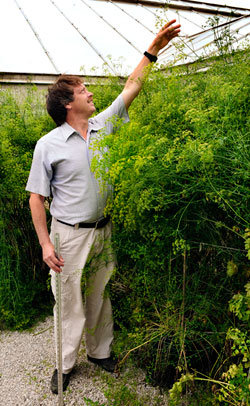World’s biggest parsley plant grown by Iowa State University researcher
06-25-09
Contacts:
David Brenner, Agronomy, (515) 294-6786, dbrenner@iastate.edu
Dan Kuester, News Service, (515) 294-0704,
kuester@iastate.edu
World’s biggest parsley plant grown by Iowa State University researcher
AMES, Iowa - A 7 foot 9 3/8 inch parsley plant grown by an Iowa State University researcher is the largest ever in the world, and the grower is now waiting for the Guinness Book of World Records to recognize the feat.
David Brenner, a plant germplasm curator working for ISU's
agronomy department, wasn't trying to set a record when he
planted the parsley last year, but he knew that the old record
was within reach.
 David Brenner
inspecting his record-breaking parsley.
David Brenner
inspecting his record-breaking parsley.
"I knew the record was attainable, so I was keeping my eye
on what the plants were doing," he said.
Brenner surpassed the old record of 6 foot set in Germany in
2007 by a remarkable 1 ft. 9 3/4 inches.
Brenner planted the parsley seeds in March 2008, and closely
watched the plants in case they showed promise. When he dug the
plants up last fall to move them into a greenhouse for the
winter, he was amazed by the growth.
Parsley is a biennial plant, meaning that it takes two years to
reach maturity.
"These were the biggest parsley roots that I'd ever
seen," he said. "I think that's what provided the
strength to grow so tall this spring."
During most of the winter the parsley didn't look like a
record breaker to Brenner.
"Almost all winter, it was cool in our greenhouse and it
(parsley) looked like something you'd buy in the
supermarket," he said.
This spring, Brenner and staff members Sam Flomo, agricultural
specialist, and Heather Westemeyer, chemistry student, moved
the parsley back outside. Soon, the plants really started to
grow quickly from horizontal, spreading leaves to a tall,
vertical stalk.
"I realized in May that they were getting about the size
of the record, so I e-mailed Guinness," said
Brenner.
Even though his parsley is clearly taller than the current
record, Brenner has to wait to see if Guinness will recognize
his plants.
"There are lots and lots of rules about how to get them
measured and other things, so I have to wait to see what they
say," Brenner said.
Brenner, who held the largest amaranth record for a few years
starting in 2004, knows that he may not hold the mark for
long.
"I don't think we are at the biological limits of this
species," he said. "Another person could come along
and beat me out."
The parsley plants were grown by Brenner as part of his job at
the North Central Regional Plant Introduction Station (NCRPIS),
run jointly by Iowa State University and the United States
Department of Agriculture as part of the U.S. Plant Germplasm
System.
Brenner is responsible for maintaining parsley and other seeds
from all over the world in the station's seed bank
including 12 types of plants comprising more than 8,000
varieties.
When the seed inventory of any certain variety or its
germination gets low, Brenner and his staff grow the plants at
the station, characterize their traits, harvest the seeds and
store them in the NCRPIS cold storage facility. These are sent
to researchers around the world.
The seeds of the record-breaking parsley plant, known as PI
507966, were first collected from Hungary in 1983.
-30-